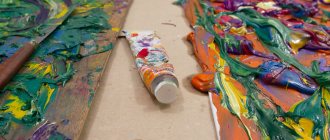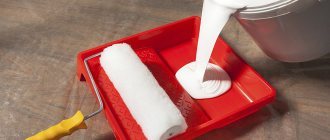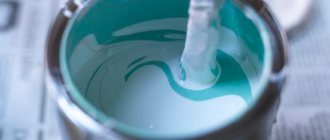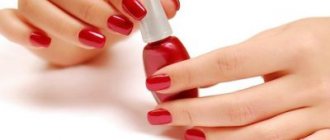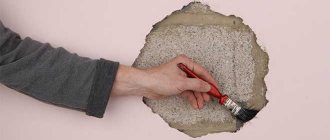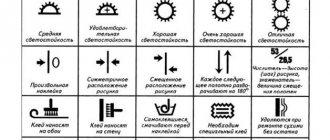When carrying out painting work in an apartment or house, people sometimes forget about safety measures, and after some time they notice unpleasant sensations. This is nothing more than paint poisoning. This condition is extremely dangerous to health, so it is important to know its main symptoms and first aid measures.
Causes of poisoning from paints and varnishes
Along with material costs, renovating an apartment is sometimes harmful to health.
Most paints and varnishes are toxic.
If the owner of the house performs work without following safety rules, he may be poisoned by the smell of paint. Evaporating chemicals entering the body through the respiratory tract cause intoxication.
The heavy metals they contain – arsenic, lead, copper, zinc – cause harm to the body. In addition to them, the materials contain synthetic dyes. Solvents with volatile ingredients pose an even greater health risk:
- butyl acetate;
- trichloroethane;
- toluene;
- acetone;
- dimethyl ketone;
- carbon tetrachloride;
- butanol;
- solvent.
It is not difficult to get intoxication using parquet varnish. The cause of floor varnish poisoning is the polymer materials included in its composition.
All paints used at home during repairs and in everyday life are toxic to one degree or another. Products used to paint walls are considered especially harmful:
- Alkyd paints contain many chemical additives. Of these, oil products have pronounced negative properties.
- Aerosol spray solutions penetrate most deeply into the respiratory system, damaging the pulmonary alveoli.
- Adhesive-based paints cause additional negative effects.
- There are known cases of harm to health from alkyd enamel of the PF brand used to paint the walls of the entrance.
- Water-dispersion, silicate, and emulsion solutions are relatively safe.
Toxin poisoning occurs not only from paints during repairs, but also from careless use of household chemicals. For example, “Whiteness” contains toxic chlorine or alkali .
Women who use hair dyes may experience headaches and allergic reactions from ammonia in these products.
Vinegar poisoning often occurs in everyday life if it is not stored or used correctly. Intoxication with mercury vapor develops when inhaling liquid metal vapor from a broken thermometer or fluorescent lamp.
Types of paints
Paints have a rich classification. First of all, they can be divided according to the composition and method of painting surfaces.
Composition and method:
- Alkyd, for example, oil. Contains harmful substances that in vapor can cause an allergic reaction, shortness of breath, and intoxication;
- Silicate. Paint intoxication is only possible if safety precautions are violated - the room is not ventilated or the substance gets in through the gastrointestinal tract;
- Adhesive. A mixture of adhesive solution and oils has a serious impact on human health, it is recommended to take precautions with such solutions;
- Water-dispersed. Poisoning is impossible because it does not contain solvents;
- Emulsion. The composition is non-toxic, does not cause intoxication or allergies due to a chemical odor. Popular among consumers, like water-dispersion paints.
Effect of paint fumes on the body
The smallest aerosols, entering through the respiratory tract, are absorbed into the blood and then spread to all organs. If you smell paint, the following changes occur in the body:
- increased heart rate, decreased blood pressure;
- damage to the organs of the reproductive system;
- chemical burn of the throat and bronchi;
- upon contact with skin, the paint causes irritation or allergies;
- inflammation of the lung tissue;
- synthetic resins included in floor varnish cause allergies, especially in children;
- teratogenic effect – damage to the fetus of pregnant women;
- blurred vision due to damage to the cornea;
- If swallowed, dyes cause liver and kidney damage.
What tests need to be taken
Deterioration in health cannot always be detected by external signs. To identify possible complications after intoxication, the following tests must be performed:
- blood for biochemistry;
- general urine analysis;
- Ultrasound of internal organs;
- electrocardiogram of the heart.
In severe cases, examinations of the lungs (x-ray) and bronchi (bronchoscopy) may be required. They are carried out in a hospital setting as prescribed by a doctor.
Symptoms of paint vapor poisoning
If you inhale paint, acute poisoning occurs. Its severity depends on the concentration of vapors in the air of the apartment. If the safe level is exceeded, paint vapors threaten the health of every person. Women are especially sensitive to them during pregnancy. People experience symptoms of paint poisoning:
- dizziness;
- disorientation in space;
- burning in the throat and eyes;
- redness of the conjunctiva and lacrimation;
- smell of acetone coming from the mouth;
- diarrhea;
- redness, itching of the skin;
- severe nausea with bouts of vomiting;
- increase in body temperature to 38–39 °C;
- cough, sneezing;
- sleep disturbance;
- pale or blue skin;
- stomach ache;
- rapid breathing;
- drowsiness;
- loss of consciousness;
- convulsions.
Signs of poisoning with alkyd wall paint are observed among those who like to do their own repairs. Intoxication also develops when inhaling acetone vapor while painting the floor with varnish. The substance is a mild narcotic toxin. Causes euphoria similar to alcohol intoxication, headache, dizziness. In large doses it affects the kidneys.
In professional painters, intoxication develops gradually and is chronic. It manifests itself with the same symptoms as acute poisoning.
Special factors
The deterioration in well-being observed when working with paint is violated can easily be confused with such an equally common phenomenon as an allergy to the smell of paint.
If a person is unaware of his body’s nonspecific reaction to paint and varnish materials, he can easily confuse the first signs of an upcoming attack with paint poisoning. There may be discomfort in the nose, dizziness, pain in the eyes, lacrimation, and bad breath. With an allergy, some time after contact with the provoking factor, specific causes of poor health begin to appear, which distinguishes it from poisoning:
- itching, peeling,
- the appearance of skin rashes,
- My head hurts even more intensely.
In addition, even after stopping contact with the dye, you can still smell it in your nose. If you do not pay attention to this condition for a long time, it becomes chronic. The consequences can be extremely severe, including disability.
The occurrence of a severe allergic reaction requires immediate contact with a medical facility and adequate treatment.
In addition to allergy sufferers, two more groups of people may suffer from poisoning by dyes:
- pregnant women,
- children.
During intrauterine development, the baby breathes oxygen supplied by the mother. The poisoned air she inhales passes through the circulatory system to the fetus, which increases the risk of defects in the genitourinary system and negatively affects the further quality of lung function. Therefore, pregnant women should refuse to participate in renovations (even of the future nursery), so that neither the expectant mother nor the child suffers from the influence of paint.
Children are no less sensitive to the vapors of coloring compounds. The symptoms of poisoning mentioned above may become stronger in them and have more severe health consequences.
First aid for poisoning by paints and varnishes
Everyone should know basic measures that will help prevent poisoning from paint fumes. Forewarned is forearmed. For mild signs of intoxication, it is enough to take self-help measures:
- First of all, you need to leave the room where repairs are being carried out, preferably go outside. Change clothes that have absorbed toxins. These actions will stop further vapor absorption.
- To relieve the condition, rinse the damaged body segments and eyes with tap water. Rinse your mouth.
- If you feel nauseous, drink water and induce vomiting. Then take enterosorbents - Polysorb, 5-6 tablets of activated carbon with water or Enterosgel.
- Toxicologists do not recommend taking a popular product - milk - in case of paint poisoning. It only makes the condition worse.
- To speed up the elimination of toxins, drink plenty of fluids in small doses: 50-100 ml every half hour.
When trying to remove varnishes and paints, do not rub the skin with a rag or washcloth . The expanded capillaries enhance the absorption of toxins. Simply remove the substance with a cotton swab.
If a person loses consciousness, call an emergency team and hold a cotton swab with ammonia to his nose. Lay the victim on his side, turning his head, bend the underlying leg at the knee joint to stabilize the position.
First aid and treatment measures
In case of poisoning by paints and varnishes, first aid should be provided as soon as possible. General procedure:
- Take the victim outside.
- Providing alkaline drinks (milk with soda or water with sugar and soda) in large quantities is the best treatment until doctors arrive.
- If there is a loss of consciousness, the poisoned person is placed on his side, his head should lie freely, one leg should be bent at the knee to avoid falling over. To bring the victim to consciousness, a cotton swab moistened with ammonia is brought to the nose.
Indirect cardiac massage and other resuscitation measures, if the necessary skills are available, can be performed not only by a medical professional. Treatment of poisoning is carried out in the toxicology department of the hospital.
Treatment of poisoning
The victim is taken to the toxicology department in serious condition.
Poisoning of any severity in children and pregnant women requires medical intervention.
Medicines
In the hospital, doctors treat paint poisoning depending on the severity of the patient’s condition:
- intravenously infused solutions that remove toxic components from the blood and organs;
- carry out forced diuresis using diuretics;
- if necessary, medications are administered to improve cardiac activity;
- liver damage is treated with hepatoprotectors (Essentiale, Silibor, Karsil);
- immunomodulators and vitamins are used.
Further drug therapy is prescribed by the clinic doctor under the supervision of tests.
Professional builders use plasmapheresis for chronic poisoning with kidney damage.
Folk remedies
For paint poisoning, medicinal herbs are used:
- Horsetail infusion helps with kidney damage. Prepared in a water bath. Take 1 tbsp per glass of water. l. dry grass. Leave for 15 minutes. Take 50 ml three times a day before meals for 2 weeks.
- Licorice decoction is prepared by boiling. Measure 20 grams of plant root per half liter of water. Keep on low heat for a quarter of an hour. Should be taken after filtering, 100 ml three times a day for 2 weeks.
- The easiest way to prepare an infusion of knotweed is in a thermos. Place 4 tbsp per liter of boiling water. l. raw materials. Leave for 2-3 hours. After straining, drink half a glass 3 times a day. The course of treatment is repeated after a month.
Herbal medicine methods significantly help remove toxic substances from the body.
Preventive actions
It is easier to prevent poisoning from paint fumes than to subsequently deal with the damage caused to health. Necessary preventive measures when working with paints and varnishes are:
- work in protective clothing, gloves, mask or respirator;
To work with paint, you must be guided by certain knowledge and skills. A frivolous attitude towards painting work, carelessness and carelessness in handling paints can lead to irreversible consequences.
When carrying out painting work in an apartment or house, people sometimes forget about safety measures, and after some time they notice unpleasant sensations. This is nothing more than paint poisoning. This condition is extremely dangerous to health, so it is important to know its main symptoms and first aid measures.
Consequences
As a result of paint vapor poisoning, all organs are affected. The respiratory tract is damaged first. Long-term painting work leads to the following consequences:
- allergic reactions occur - rhinitis, conjunctivitis;
- a burn of the bronchial mucosa is accompanied by shortness of breath with difficulty breathing;
- paint vapors, irritating the conjunctiva, lead to visual impairment up to complete blindness;
- hallucinations, convulsions are caused by damage to the nervous system;
- after the absorption of chemical toxins into the blood, the kidneys and liver are affected with the development of functional failure of these organs;
- patients suffer from frequent headaches and sleep disturbances;
- chronic gastritis, gastroduodenitis develops;
- laryngitis with hoarseness due to damage to the vocal cords.
Severe poisoning manifests itself as chronic hepatitis and nephritis, for which people undergo treatment for years.
How the smell of paint and extraneous noise disrupt brain function
Autumn is the time of year when residents of the less warm regions of our country begin to make repairs, counting on the fact that the heating turned on after the summer cold will help the paints, plaster and wallpaper glue to dry quickly. However, do we know what chemical processes occur in drying paint and how the substances released during this process affect our health?
Experts note that paints are divided into two large groups: those whose base consists of water (they are usually called acrylic emulsions), as well as solvent-based paints.
Lost sense of smell - straight to the grave
Loss of smell in old age is a very serious sign. Scientists have found that with a large...
03 October 09:44
Both types of paints contain solvents (mixtures of light hydrocarbons) and volatile organic substances, including alcohols, hydrocarbons, aldehydes, ketones and others. All these classes are capable of being released into the air in fairly significant concentrations even at room temperature and normal pressure from paints and varnishes when they dry.
A research team led by Erica Sabbat from the Center for Population and Development Studies at Harvard University decided to find out how quickly the brain is able to recover from this exposure. The results of the work were published
in the journal Neurology.
The direct mechanism of influence of substances released by paints has been studied repeatedly, and articles about this have been published in many scientific journals: for example, Indoor Air
and
Canadian Medical Association Journal
.
Scientists have found that volatile organic substances enter into chemical reactions with nitrogen oxide, resulting in new compounds. They cause irritation of the mucous membranes of the eyes, nose and larynx, provoke headaches, nausea, loss of coordination of movements, cause damage to the liver, kidneys and central nervous system. Scientists suspect some of these volatile organic compounds to cause cancer—the World Health Organization says painters have a 20% higher than average
.
Erica Sabbat's study involved 2,143 people who, due to their work, were constantly exposed to substances released by paints and varnishes. 33% worked with chlorine-containing solvents, 26% with benzene, and 25% with hydrocarbon-based solvents. At the time of the study, all subjects had already completed their professional activities and were not constantly exposed to chemicals, being retired for an average of ten years (however, there were also those who left hazardous work half a century before the study). Participants completed eight tests designed to determine people's level of cognitive ability.
As a result of the work, it turned out that the level of mental abilities of the subjects was below normal. The worst results were demonstrated by those who last worked with chemicals relatively recently - 12–30 years before the experiment.
These people had difficulty remembering information perceived by ear, and their ability to recall facts they already knew was reduced. This is tested using tasks such as, for example, listing as many names of wild animals as possible in one minute. However, a complete surprise for scientists was the fact that the brain is not able to recover from exposure to solvents and volatile compounds even 30–50 years after leaving work - in this case, the negative effects were less pronounced, but still went beyond the norm. “The subjects had problems with the functioning of even those parts of the brain that are not believed to be affected by solvents. However, as it turns out, they also have side effects in these areas of the brain,” comments lead author Erica Sabbat. By the way, her research group was able to find out another interesting fact - the degree of negative impact of solvents and volatile organic compounds on the brain is directly related to the formation of:
The better educated a person is, the less the evaporation of varnishes and paints affects his mental abilities.
A separate article was devoted to this discovery, which was also published
in the journal Neurology.
However, inhaling vapors from paints and varnishes is not the only danger that awaits a person during repairs. Typically, interior remodeling involves noise: drilling, nailing, replacing flooring, inserting new window frames. However, it is impossible to definitively answer the question of how noise affects the functioning of our brain. So, a few weeks ago the European Heart Journal published a study
, the authors of which assure: noise from highways can significantly shorten a person’s life. It turned out that where daytime noise exceeds 60 dB, people die 4% more often than in areas with noise levels less than 55 dB. Adults living in areas with the loudest traffic (greater than 60 dB) are 5% more likely to be hospitalized with a stroke than those living in quieter areas (less than 55 dB), and for older adults the figure is 9% . Scientists say deaths and strokes may be caused by high blood pressure, sleep disturbances and noise stress.
It is worth noting, however, that the article is talking about very loud noise. The effect of white noise on our brain function is very beneficial: it has been proven
that it improves children's ability to remember new information. However, in real life, pure white noise—the spectral components of which are evenly distributed across the entire range of frequencies involved (an example is the sound produced by a nearby waterfall)—is not very common.
But the noise that we are forced to listen to more often: the sounds of renovations in the apartment, telephone conversations of office colleagues, voices and music of television programs - does not lead to death, but it significantly interferes with work and concentration.
The noise outside the window takes away life
British scientists have proven that people get sick and die more often if they live where road noise is louder. Most…
June 24 09:29
Mark Andrews, professor of physiology at Seton Hill University
, Pennsylvania, USA),
told
Scientific American: “Little background noise at home, work or school often makes it difficult for people to concentrate. According to the National Institute for Occupational Safety and Health, background noise also affects human health by increasing stress levels and consequently causing high blood pressure, coronary heart disease, stomach ulcers and headaches. Prolonged exposure to noise does not lead to addiction - on the contrary, the situation only gets worse.
Some studies have shown that stress caused by white noise increases the production of the hormone cortisol, which helps the body restore homeostasis.
after any physical shock. However, “extra” cortisol affects the functioning of the prefrontal cortex, the center responsible for emotions and learning, which allows us to control our desires, plan and make decisions. Recent research also shows that the prefrontal cortex is responsible for the formation of short-term memory. Therefore, changes in the functioning of this area can prevent a person from thinking clearly and remembering information. In addition, noise-induced stress affects other brain functions, including learning and long-term memory."
Prevention
To avoid toxic paint poisoning during work, it is enough to follow the safety rules:
- It is preferable to use water-soluble paints, applying them with a roller rather than a brush. When aerosol spraying occurs, the worker actively inhales toxic substances.
- Paint walls, ceilings and floors in a special respirator with replaceable cartridges. No cotton mask can protect the respiratory organs from damage.
- Use safety glasses and rubber gloves.
- During the period of painting furniture, the room must be ventilated or provided with ventilation.
- During work, take breaks and periodically leave the repair area. As soon as the smell of acetone appears in your mouth, immediately go out into clean air.
- The protective measure includes choosing safe paints that do not have an aggressive odor. These include powder materials that are used to paint walls in a child’s room and a room where people with allergies live. Even when heated, these paints do not emit toxic substances that can lead to poisoning.
- Safe acrylic paint is recommended for painting furniture.
Keep solvents and gasoline in special closed places. Keep paint and varnish materials out of the reach of children.
Paints and varnishes are chemicals that can cause serious harm to health if handled incorrectly. To avoid the negative consequences of their use, it is enough to follow the above advice from chemists and doctors.
Precautionary measures
The damage caused by paint odor is great, and it is better to prevent the harmful effects than to treat them. (See also the article How to get rid of paint smell in an apartment: options.)
Therefore, it is recommended to take care of your health in advance:
- Use personal protective equipment while applying paint . The price of the same respirator is significantly lower than the cost of your well-being.
Respirator example
- Constant thorough ventilation . Open all windows and doors wide when painting, and circulate air around the clock. Limit your stay in the danger zone as much as possible.
- Placing peeled heads of onion or garlic will neutralize offending aromas . Arrange them so as to optimally cover the area affected by the odor.
Natural Toxin Detoxifier
- Hanging wet sheets and towels have the ability to absorb odors . Replacing them frequently will help get rid of harmful fumes faster.
- Burning candles can also cleanse a room . Place them around the perimeter and control their combustion process.
- An air ionizer can create excellent protection against possible poisoning by eliminating dangerous elements in the room . But here you should compare its cost with the volume of expected work. (See also the article Wall decoration: features.)
Air ionizer sample
How to help a person with paint intoxication
What to do if you are poisoned by paint? First of all, you should take the person outside or into a room with clean air. The more he comes into contact with this chemical, the more poisoned he will become.
Remember that first aid to the victim can only be started in a room with clean and non-poisoned air. Don't forget about your safety.
After taking the victim out into the fresh air, immediately call an ambulance , describe to the dispatcher by phone in detail the patient’s symptoms, the circumstances of contact with the paint and correctly name your location. Treatment of paint odor poisoning is carried out in an intensive care unit or toxicology department. While the EMS team is on its way to you, begin providing first aid to the victim. This can slightly improve the patient's well-being.
Please note that self-medication for paint poisoning is dangerous. It can lead to severe disruption of internal organs and death.
First aid for paint poisoning:
- Provide the patient with free access to air. Unbutton his shirt and tie, open all the windows in the room wide open.
- Rinse your eyes, face and hands with running water. If paint gets on your skin, try to wash it off.
- Cleanse your stomach. To do this, you need to drink a liter of plain water and induce vomiting. Potassium permanganate or any other substances should not be added to the gastric lavage solution.
- After gastric lavage, the patient can be given sorbents. This can be activated carbon, smecta, atoxyl, sorbex or enterosgel. Sorbents should be taken to relieve intoxication of the body.
- Give the person something to drink. It can be warm sweet tea, mineral or table water, compote, milk.
- If the victim is unconscious, place him on a flat surface, turn his head to the side, and monitor his breathing and pulse. It is most convenient to check the heartbeat on the carotid artery, which runs on the anterolateral surface of the neck. Breathing can be checked by placing your hand on the patient's chest. If breathing and pulse stop, indirect cardiac massage should be started.
